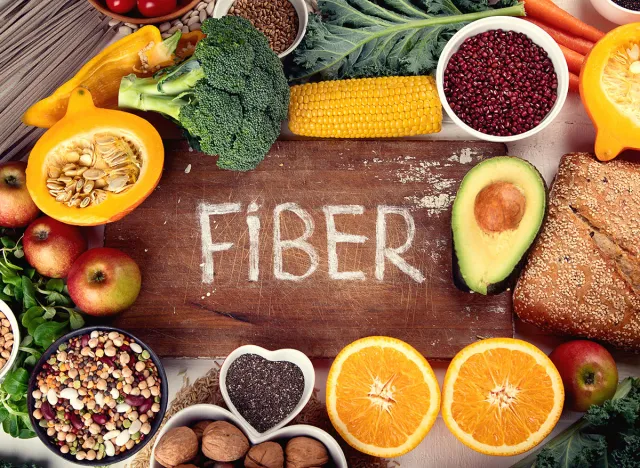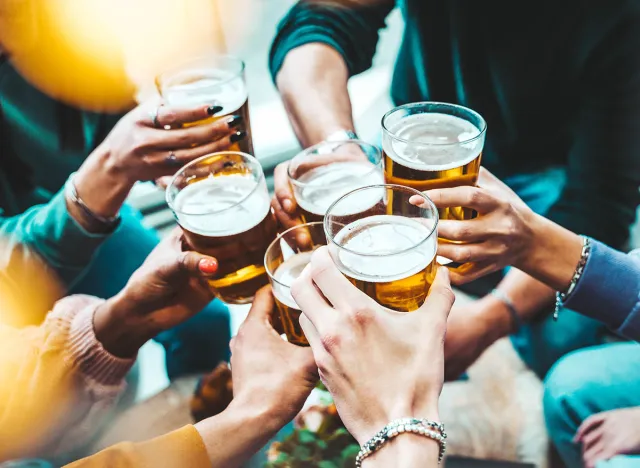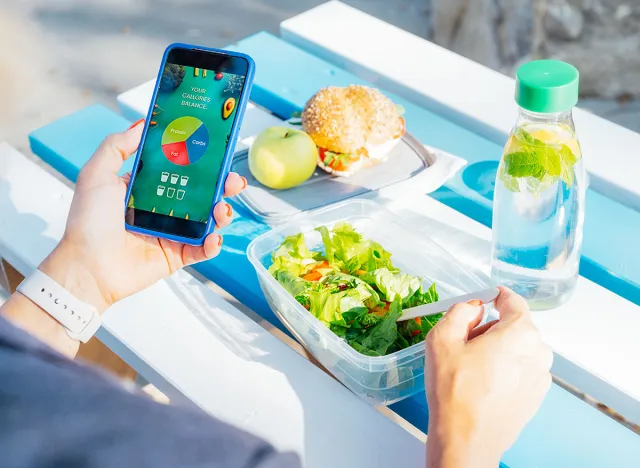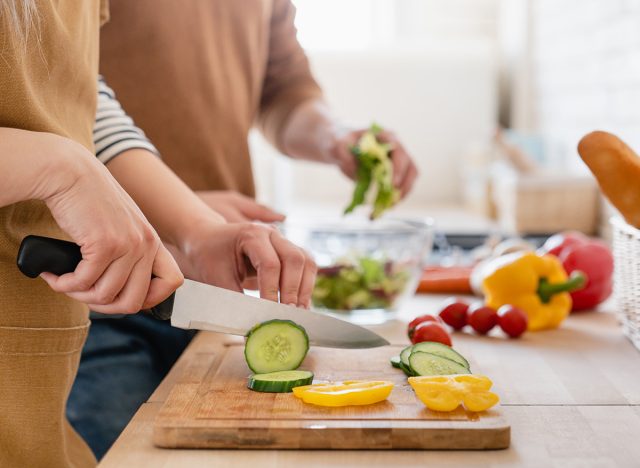10 Secret Fat-Burning Tricks That Melt Pounds Away Even After 40
Do you want to lose weight quickly and keep it off? It may come down to incorporating a few healthy habits into your lifestyle. Louise Corrans is a wellness influencer who regularly shares tips on how to stay in shape past age 40. In a recent viral video, she reveals easy ways to lose weight fast. "In today's video, we will cover ten fat loss principles that I swear by and that you need to follow if you want to lose fat at any age and at any stage. Yes, even over 40," she says.
Maintain a Caloric Deficit
Principle number one: "You need to be in a calorie deficit to lose fat to lose weight," says Corrans. "You have to be in a calorie deficit because that will allow your body to turn to its own fat stores for the energy that it needs that day. That is why a calorie deficit always works. It's not about whether you are having special foods or only certain magical foods for fat loss. There are no magical foods for fat loss. It is energy in, energy out," she explains.
Prioritize Protein
Number two, protein first. "No, this principle is the most important when it comes to maintaining your muscle mass," she says. "Protein first means that you just want to meet your protein needs for the day so that during your fat loss phase, you are not risking losing your muscle." She adds that the older you get, protein becomes more important in order to prevent sarcopenia, "which means we are losing muscle mass, we are anabolic resistant, which means it's harder for us to grow muscle and protein with all those amino acids." She recommends "around one gram of protein per pound of body weight, your ideal body weight, not your overweight body weight."
Amp Up Fiber Intake

Number three is fiber. "Fiber is so important for gut health. It feeds our good gut bacteria. If you are getting enough fiber, you don't need prebiotics, and your gut health should be good. It helps with motility. It helps you to feel fuller for longer. It helps slow the digestion of your food down. It helps with blood glucose. Fiber has also been shown to be one of the things that prevents all causes of mortality," she says. "So make sure you are getting in enough fresh vegetables with most of your meals throughout the day."
Minimize Fats
"Number four is to keep your fats to a low or moderate amount. The reason is not that fats are bad; there's nothing wrong with fats, but if you are eating a high-fat diet, of course, you've got no room in your calorie budget for much else," she says, explaining that fats are "so calorie dense" with nine calories per every gram of fat, while a gram of protein or carbs only has 4. "For me personally, it makes sense to fill up on the proteins and the carbs. The carbs give our muscles energy, especially if you're doing some form of resistance training or exercise. Protein, as I've spoken about in number two, is vital for us, especially as we age."
Reduce Alcohol Intake

"Fat loss principle number five is very little to no alcohol. I cannot stress this enough. When I stopped drinking alcohol, the weight did come off, but obviously, I had to be in a caloric deficit anyway. But I found that drinking alcohol, even if it's just a few drinks on the weekends with friends, was sabotaging my weight loss goals because I made bad food choices," she claims. This is because you end up eating unhealthy food and "not remembering what you ate. You are eating the wrong foods," she says. It ends up negatively impacting your sleep and "depletes your electrolytes, it dehydrates you, it makes you feel like crap," she says. "Then obviously, the older we get, the more it takes two to three days to recover, and your body is just prioritizing the elimination of that toxin. And yes, alcohol is a toxin. So, this is not a judgment. It's not telling you that you are bad if you have a few glasses of wine, but just remember that it could be sabotaging your weight loss goal."
Incorporate Resistance Training
Principle number six is resistance training. "I would pick resistance training over cardio any day for fat loss because you're stimulating your muscles, you're telling your body you want to hold onto or even grow a bit of muscle tissue. And muscle does burn more calories at rest than your fat cells," she says. "So muscle is very metabolically active. Your body is going to use calories to grow muscle tissue. It's going to burn more calories at rest. When you have more muscle tissue, you're going to look sexier, you're going to be stronger, you're going to feel like you are capable, and you wanna do more and move more throughout the day."
RELATED: Top 10 Breakfast Foods to Burn Fat You Should Eat Every Day, According to a Top Bodybuilder
Track Your Food

Number seven? "Track, track, track your food. And when I say track your food, weigh your food so that you can track it accurately," she instructs. "I myself have been very resistant to doing this for many, many years. I would track a bit, then I would stop, and I would get fatigued, and I wouldn't be weighing my food. I would be just eyeballing it and guessing," she says. "The only way to be accurate when you track your food is to weigh and measure it. So you are tracking 100 grams of that amount, whether it's cooked or raw. Make sure your track is saying cooked or raw, and then you know that what is coming into your mouth is that, and then you can sort of see your progress, your measurements, your weight, and then you can assess if that amount of calories that I'm actually eating having an effect on my weight loss? Or do I need to adjust? So the data and the knowledge, it is power."
Stick to Whole Foods
She also recommends opting for "whole foods in their most natural form as far as possible." While you can shy away from them on occasion, "for health and for general weight loss and just to feel good food choices do matter. So fresh whole foods are always going to be your better option," she says. "For example, sweet potato, and potato with the skin on lots of vegetables, lots of low starch vegetables, starchy vegetables for your carbs, lean meats, fish, nuts and seeds," she says. "In general, you want to choose foods that you would find in the most natural form for your overall health, and it will help you with your weight loss goals."
RELATED: 3 Appetite Suppressants That Are Better Than Ozempic, According to Expert
Cook Your Own Meals at Home

"Number nine, you must cook your own meals at home because then you know exactly what has gone into the food that you're putting into your mouth," she says. She uses the example of eating sushi. Even though you think it's just white rice, it likely has sugar or oil added to it. "There is so much hidden in restaurant food that not to say you can never go out and have restaurant food, but if you do that too often, you could very likely be sabotaging your weight loss goals. So make your food at home, have your food prepared, have lots of healthy food on the go and on the ready so that you make good food choices and you will see your fat loss goals realized and achieved," she says.
Maintain a Positive Attitude
Principle number 10 is to approach weight loss with a "happy with a positive attitude," she says. "You cannot go into a fat loss phase or go on a weight loss journey with this negative mindset of, 'I can't have this. I'm not going to be able to do it. I'm now going to be miserable. This is terrible. Poor me, I can't eat this food. I can't have that.' Please, please, please go into it with a positive attitude because then you are much more likely to achieve your goal. You're much more likely to have fun along the way. You are much more likely to actually learn the skills that you need to learn in order to tackle this weight loss goal. And remember, this is a beautiful and fun journey that's going to result in better health outcomes. You're going to achieve your dream body, which is so exciting," she continues. "Just imagine how good it's going to feel to shop for clothes that you've been longing to fit into and to shop for." And if you enjoyed this article, take advantage of these 15 Quick Ways to Lose Body Fat Percentage in a Week.





